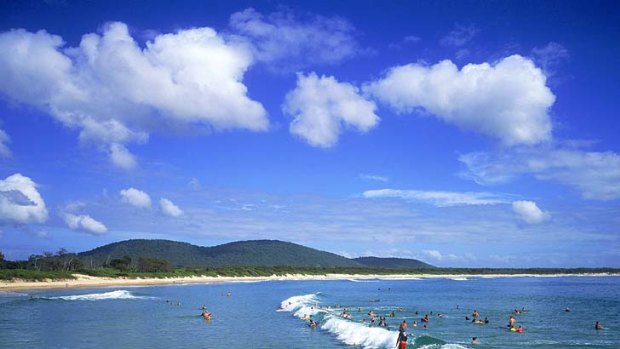This was published 9 years ago
Crescent Head, New South Wales: Travel guide and things to do

Surfs up ... Crescent Head is a favourite with a longboard riders around the world.Credit: Getty Images
Located 446 km north of Sydney and 19 km south-east of Kempsey, Crescent Head is one of the best kept secrets on the northern New South Wales coast. A delightful sleepy little coastal village it is characterised by beautiful beaches and a headland which features one of the most spectacular cliffs on the eastern coast of Australia. It is also a well-respected surfing destination which offers good fishing both from the beach and the rocks. The tiny township is well-protected environmentally with the Goolawah Reserve and Limeburners Creek Nature Reserve edging it to the north and the south.
Although the district around Crescent Head had been thoroughly explored by the 1830s no settlement was established in the immediate vicinity. It is only in recent times that this quiet stretch of coastline has been recognised as an ideal and quiet holiday destination. A town eventually emerged and it is presently characterised by 1950s style accommodation with many fibro holiday homes.
The peacefulness of the town is largely a result of its unusual location. Travellers have to make a conscious decision at Kempsey to depart from the main Pacific Highway and head in a southerly direction. As most travellers are heading north they are unwilling to go backwards down the coast. This circumstance seems designed to ensure that Crescent Head will never be inundated by large numbers of tourists.
Of some historic interest is the fact that the S.S. Wollongbar was torpedoed by the Japanese off Crescent Head on 29 April, 1943 with a loss of 32 lives.
Today Crescent Head is noted as one of the finest surfing locations on the New South Wales coast. The headland has helped to produce almost unique surfing conditions which have attracted such greats as Midge Farrelly and Nat Young.
Things to see
Visitor Information
Visitor Information, which is nothing more than a map, is located on the wall of the Shell Garage in the centre of town.
Crescent Head
To reach the actual headland, turn at Baranghi Street beside the Shell Service Station, turn into Korogora Street and then into Skyline Crescent.
Crescent Head is a wonderfully deceptive craggy outcrop. That fine Australian tradition of despoiling the landscape has reached some kind of metaphorical highpoint with a huge, ugly concrete water tower sullying the promontory.
Look south and far, far below is a beach with the headland tumbling through thick tufts of banksia to a long, pale arc of sand. And below, on a lower headland, is the solitary grave of Herbert Arnold O'Dell who died on 1 September 1917 at the age of 26 years and 5 months while he was fishing off the rocks at Crescent Head.
The views from Crescent Head are spectacular. It is a sheer fall of nearly 100 metres.You can see as far south as Point Plomer and as far north as Hat Head. The wind from the south buffets the banksias which seem to cringe against its force.
Goolawah Reserve
Goolawah Reserve occupies a peaceful 10-km coastal strip to the immediate south of Crescent Head. Consisting of typical seaside Australian bushland (lots of melaleucas and banksias), it is ideal for bushwalking, surfing and holidaying. There are two camping grounds - Delicate and Racecourse - where it is possible to set up a tent or park a caravan.
Limeburners Creek Nature Reserve and Point Plomer
10 km south of Crescent Head is Limeburners Creek Nature Reserve which is 9123 hectares of coastal heathlands characterised by banksias, blackbutt wetlands and small pieces of rainforest. The area is ideal for birdwatching, swimming, surfing, canoeing, bushwalking and fishing. There is a primitive camping area at Melaleuca Rest Area (near Big Hill) and there are picnic areas at Queens Head and Big Hill. A loop walk commences at the latter site. It winds about the summit of the headland, offering dramatic perspectives down wave-formed chasms and over the coastline, before descending into coastal rainforest.
The area between Big Hill and Point Plomer is of historical significance to the local Aborigines who occupied the area for five or six thousand years prior to European colonisation. There is an ancient Aboriginal fish trap at Barries Beach which is said to be one of only three now left on the mid-north coast. There are also shell middens, burial sites, open campsites, a large stone tool working site and a quarry for stone tool production.
The reserve's name derives from the early days of European settlement when oyster shells from the creek were burned in prodigious numbers to produce lime for mortar. Free settlers moved into the area in the 1830s when the penal settlement at Port Macquarie was wound down. The area adjacent the creek was declared the Orara Gold Field in 1881 though returns seem to have been insubstantial.
After their initial decimation, oysters returned and the creek is now the region's principal source of the shellfish.
There is a camping area with showers and toilets at Point Plomer which is little more than a few fibro houses, a general store and a service station.
For more information and details about booking into the reserves contact the Kempsey Tourist Information Centre (tel: 02 6563 1555 or, toll-free: 1800 64 2480) or the Port Macquarie District National Parks and Wildlife Service Office on (02) 6584 2203.
Tourist information
Kempsey Tourist Information Centre
Lachlan St (Pacific Hwy) Kempsey
Crescent Head NSW 2440
Telephone: (02) 6563 1555, 1800 64 2480
Facsimile: (02) 6563 1537
Sign up for the Traveller Deals newsletter
Get exclusive travel deals delivered straight to your inbox. Sign up now.